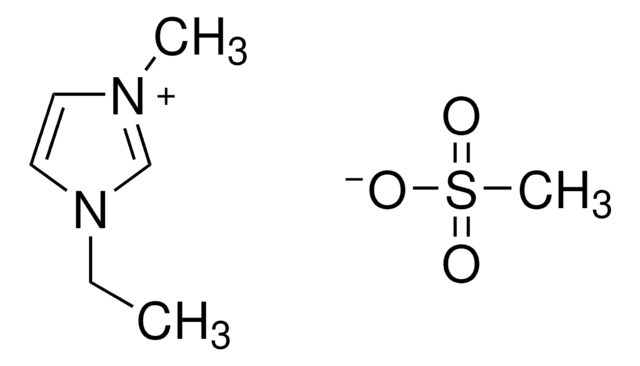900787
1-Ethyl-3-methylimidazolium acetate
≥98%
Sinónimos:
EMIM Ac
Seleccione un Tamaño
531,00 €
Seleccione un Tamaño
About This Item
531,00 €
Productos recomendados
Nivel de calidad
Ensayo
≥98%
Formulario
liquid
características de los productos alternativos más sostenibles
Catalysis
Design for Degradation
Learn more about the Principles of Green Chemistry.
sustainability
Greener Alternative Product
impurezas
≤0.5% H2O
mp
>30 °C (product can occur as an undercooled melt)
densidad
1.101 g/cm3 at 20 °C
aplicaciones
battery manufacturing
categoría alternativa más sostenible
cadena SMILES
CC([O-])=O.CCn1cc[n+](C)c1
InChI
1S/C6H11N2.C2H4O2/c1-3-8-5-4-7(2)6-8;1-2(3)4/h4-6H,3H2,1-2H3;1H3,(H,3,4)/q+1;/p-1
Clave InChI
XIYUIMLQTKODPS-UHFFFAOYSA-M
¿Está buscando productos similares? Visita Guía de comparación de productos
Descripción general
Aplicación
Producto relacionado
Palabra de señalización
Warning
Frases de peligro
Consejos de prudencia
Clasificaciones de peligro
Acute Tox. 4 Oral - Skin Irrit. 2 - Skin Sens. 1B
Código de clase de almacenamiento
10 - Combustible liquids
Clase de riesgo para el agua (WGK)
WGK 3
Punto de inflamabilidad (°F)
327.2 °F - closed cup
Punto de inflamabilidad (°C)
164 °C - closed cup
Elija entre una de las versiones más recientes:
Certificados de análisis (COA)
¿No ve la versión correcta?
Si necesita una versión concreta, puede buscar un certificado específico por el número de lote.
¿Ya tiene este producto?
Encuentre la documentación para los productos que ha comprado recientemente en la Biblioteca de documentos.
Los clientes también vieron
Part III. The first readily biodegradable ionic liquids
Artículos
Solid-state Li batteries: Review of solid electrolytes, ion conduction, structures, and electrochemical processes.
Ionic liquid electrolytes explored for rechargeable batteries' advancement; future IL development discussed.
Filtros activos
Nuestro equipo de científicos tiene experiencia en todas las áreas de investigación: Ciencias de la vida, Ciencia de los materiales, Síntesis química, Cromatografía, Analítica y muchas otras.
Póngase en contacto con el Servicio técnico










